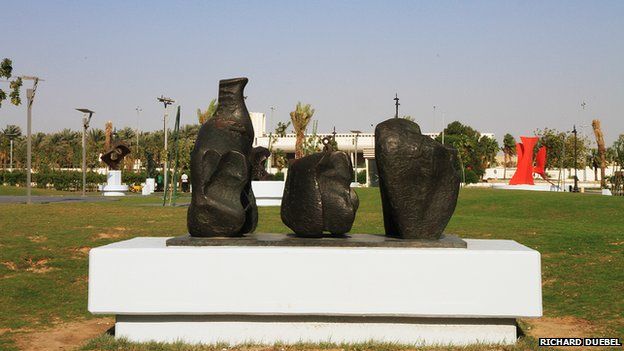Art in Saudi Arabia: Appetite fuels public displays
- Published

As curator Aya Alireza looks up at lines of gold leaves suspended in tiers from the ceiling of a disused Jeddah shopping centre, a group of schoolchildren gather around.
She explains to the cluster of curious 10 year olds that what they're looking at is a matriarchal family tree.
It is in fact an art installation by Saudi Arabian Manal Al Dowayan, the result of an informal social survey which asked Saudi women to name their female ancestry.
"Only very few women could recollect by name any female relative going back beyond four generations," Manal says. "It is as if they have disappeared, been erased from memory. This is an act of preservation."
Called the Tree of Guardians, the gilded, shimmering layers are part of an exhibition entitled 21,39 - Jeddah's geographic co-ordinates.
Although Jeddah is known as the cultural capital of the country, those involved in the art world are having to be inventive when it comes to creating exhibition spaces and giving the public the opportunity to view new works of art.
"As yet Jeddah has no public museum so this is a new way of bringing art to children - through field trips," explains Raneem Farsi, co-curator of 21,39. "We bring them here by bus. In that way we tailor ways of making art accessible in line with our religion and the criteria of our country."
New opportunities
The exhibition, the inaugural show by the newly-formed Saudi Art Council, a non-profit umbrella organisation that is helping Saudi contemporary artists exhibit at home and abroad, marks a turning point for culture in the Kingdom.
The Council is publishing art books but more significantly obtaining loans from collectors of works by pioneering Saudi artists of the 1970s. Artists like Safiyya Binzagr, who laid the foundations of today's art in the Kingdom by studying abroad and bringing back new ideas and painting styles.
Abdulaziz Awad alrashidi explains the art of Arabic calligraphy
The Council has dedicated an exhibition, Past is Prologue, to their work. "They were the trailblazers who worked for the ministry of education," explains Aya Alireza. "Many of them were reluctant to let their work be seen in public. It isn't something that has happened here before."
The new initiatives dovetail with huge developments in public transport with the construction of a 45bn Saudi riyal (£7bn; $12bn) network of trains, trams, ferries and buses, along with 72 stations as well as a new airport in Jeddah.
As Mohammed Hafiz, a gallery owner and spokesman for the Council, points out, these massive public works offer new opportunities for art to be seen in public places.
"The train stations are designed by Norman Foster," he explains. "So they will be significant buildings with large walls crying out for non-figurative art."
"The airport authorities have already been in touch with my gallery about acquiring works for the new airport terminal. Space has already been set aside for contemporary art to be exhibited in the designs. "
Cultural bridge
Jeddah, the gateway to Mecca, won an Aga Khan Award for Architecture prize in 1983 for its innovative Hajj terminal. But the new transport hubs offer even greater opportunities for Saudi artists to shine.
Airport authorities are consulting with advisers and commissioners to acquire art work, among them Saudi director general of the Institut du Monde Arabe in Paris, Mona Khazindar.
Although the public buildings will still segregate men and women, it is anticipated that this will be achieved in an innovative and stylish way, by getting the many women involved in design to apply their skills and creativity to achieve this.
Aya Alireza and Raneem Farsi are enthusiastic about the developments, feeling that a metro, with different artwork at each station, can act as a sort of cultural bridge helping women to get around until they are allowed to drive and providing them with an opportunity to see art.
"It'll teach women where places are, " says Aya. "At the moment women are dependent on male drivers and don't know the layout of the city,"
Some women use the large sculptures currently dotted about the city to get their bearings. "Many of the roundabouts have an iconic sculptures by international artists such as Henry Moore," says Raneem Farsi, whose uncle - a former mayor of Jeddah - commissioned the works in the 1970s.
"They are landmarks that everyone recognises and were funded by private individuals and families."
'Opening up'
But art isn't just assisting life in Jeddah. An exhibition in Medina, Islam's second most holy city, is the precursor to a state-of-the-art interactive museum planned to show Medina's historical importance.
"The building will lie outside the Haram district [closed to non-Muslims] and will attract visitors of all religions," says Faisal Bin Salman Bin Abdulaziz, the Governor of the province of Medina and a veteran art collector.
The exhibition, entitled Word and Illumination, juxtaposes classical and contemporary calligraphy alongside some of the earliest photographs of Medina, showing how radically the city has changed since the 1970s. It has been seen by more than 3,000 visitors.
This is, according to Amine Kabbaj, a Moroccan architect and director of the Marrakesh Biennale who was visiting the exhibition, an exciting development.
"We are seeing art being displayed more frequently in Saudi Arabia," he says. "This is a first in Medina. And the number of people who are interested is a clear indication that there is an appetite for art. The Kingdom is opening up gradually through culture."